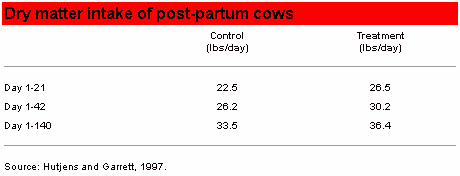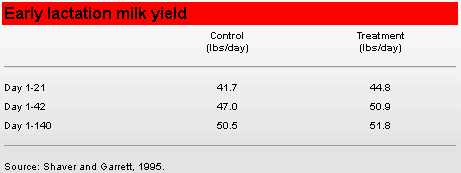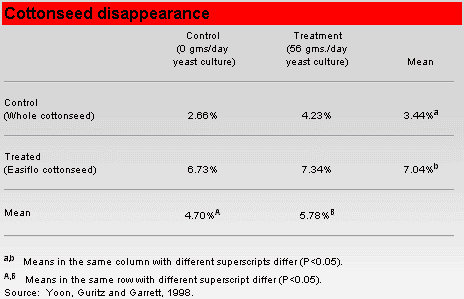Use Yeast Culture to Feed the Rumen First
Healthy rumen microbe populations are important to dairy cows. Flourishing microbial populations can provide 50% to 80% of a dairy cow's daily protein requirement and up to 80% of its energy requirements. The remainder of the cow's nutrients comes from the level of recommended daily nutrients fed. In addition, research shows that well-managed herds with flourishing rumen microflora perform more consistently with smaller fluctuations in dry-matter intake, milk production and milk components. These cows cost-effectively maintain sustained levels of high production and performance.
Half a century ago, scientists began characterizing rumen organisms. After largely demystifying the role of assorted rumen microbes in converting feedstuffs to absorbable nutrients in the rumen, scientists began testing the effect of direct fed microbials on rumen performance in the 1980s. With further advances, nutritionists today balance rations to "feed the rumen first," that is, to nurture healthy populations of rumen microflora.
Some of the products studied by scientists were yeast culture and other yeast products which nurture healthy populations of rumen microflora. These products also enhance palatability and some are heat and moisture stable. These products typically are first added to dairy rations to help maintain dry matter intake (DMI) during the transition period or periods of heat stress. After the benefits are experienced in transition cows, these products often are used to support high production levels in lactating herds. According to studies conducted by the University of Missouri, University of Kentucky and University of Texas, more than 50% of top U.S. Dairy Herd Improvement Association (DHIA) herds, and more than 35% of all U.S. commercial herds include yeast culture or yeast products in one or more herd rations.
Increase DMI
The more feed cows consume, the more energy they receive and the more milk they can produce. Because feed intake drives production, nutritionists and dairymen strive to increase DMI. By optimizing rumen fermentation or microbial activity at high DMI levels, cows maximize the level of nutrients retained from feed. The presence of the bacteria populations required to digest forages, fiber and starch helps make this possible.
Continuing investigation by independent research organizations, universities and industry suppliers confirm the benefits of including yeast products in dairy rations. These benefits are increased dry matter digestibility and an effect on milk production.
In a University of Illinois transition cow trial, treatment cows maintained higher dry matter intake (see table Dry matter intake of post-partum cows). Lead researcher Mike Hutjens, PhD, dairy extension specialist at the University of Illinois, explained that his research found the best time for including yeast products in herd rations was from two weeks pre-calving through the first 40 or 50 days of lactation.
The trial also found that cows in the treatment group used less body reserves for milk production during early lactation. Dry matter intake increased more rapidly in these cows post-calving and peak milk production was reached more quickly than in non-supplemented cows (see table Early lactation milk yield).
Increase yield
A 1995 study by Shaver and Garrett evaluated the effect of yeast culture on milk yield, composition and component yield on 11 commercial Wisconsin dairies. The study found that yeast culture addition to post-peak diets affected milk production. The level of economic response varied, however, due to ingredient costs and milk prices. In the study, the addition resulted in a 2:1 to 3:1 return on investment (assuming an increase in dry matter intake equal to 35% of the milk response). The herds included in the study consisted of approximately 1,500 cows - 1,200 lactating - with rolling herd averages that ranged from 22,000 to 28,000 lbs. per cow.
In a trial at Ohio State University, Wang and colleagues found that feeding a ration with 21% forage neutral detergent fiber and yeast culture positively affected dry matter intake, actual milk yield, 3.5% fat-corrected milk yield and milk fat from 31 to 140 days in milk. The trial showed the importance of having optimal levels of nonstructural carbohydrates (NSC) in the diet. Cows in the treatment group with less than the optimal 37% to 38% NSC did not show the positive responses typically observed. Only cows receiving a properly formulated diet with proper energy levels fully realized the benefits.
Increase digestibility
Optimum rumen fermentation also drives the digestion rate. As the digestion rate increases, the rumen empties faster and cows can eat more feed. The animal's energy demand, the diet's energy density and physical fill all limit feed intake.
Cellulolytic bacteria activity accounts for the majority of fiber digestion in the rumen. These bacteria capture most of the energy from fiber when pH is maintained at or above 6.0. By nurturing a healthy, dynamic population of cellulolytic or fiber-digesting bacteria, yeast culture helps increase fiber digestibility.
Cereal grains are routinely included in dairy rations to achieve high production levels. But, the rapidly fermented cereal grains provide substrates for rumen bacteria that produce lactate and decrease rumen pH. Fiber-degrading bacteria are inhibited as the pH drops below 6.0. Research suggests that adding yeast culture to the diet helps decrease lactate accumulation in the rumen by stimulating the bacteria that use lactate. Consequently, increasing lactate use in the rumen helps maintain rumen pH above 6.0 and increase fiber digestibility.
Three recent research trials by Yoon and colleagues at the Diamond V Mills Technical Center highlight rumen microbes improved ability to digest feedstuffs with yeast culture in the ration. A two part study indicated that treated dairy cows more fully digest corn and, hence, obtain more nutrients from the corn. The study also supported observations by dairy producers and nutritionists who comment on the fewer kernels of corn passing through dairy cattle fed yeast products.
A separate study measured corn silage degradation. The corn silage was placed in duplicate DacronTM bags and inserted into the rumen of cannulated Jersey cows. The three corn silages differed in harvest maturity, moisture, processing, inoculation and cultivation practices. Corn silage digestion improved in the treatment group and remained consistent regardless of silage type. Treated cows showed increased dry matter, neutral detergent fiber (NDF), acid detergent fiber (ADF) and hemicellulose (HC) disappearance.
The third study showed an increase in the rumen digestibility of both fuzzy and EasifloTM whole cottonseed. Easiflo cottonseed has a starch coating to improve handling. The study measured ruminal degradation of cottonseed in cannulated Jersey cows, as described above.
Significant increases in dry matter disappearance were seen with the inclusion of yeast culture to both types of whole cottonseed (see table Cottonseed disappearance). Dry matter (DM) disappearance improved by 8.7 percent for cows receiving yeast culture in their diet when compared to cows not receiving yeast culture. The treatment group also showed significant improvements in NDF and ADF disappearance.
Likewise, Easiflo-treated whole cottonseeds showed significant improvement in the disappearance of DM, NDF and ADF when compared to untreated fuzzy whole cottonseed. The coating used to treat the whole cottonseeds, however, may have partially explained this increase in digestibility.
In 1999, Sullivan and Martin conducted a study at the University of Georgia. Addition of yeast culture increased the concentration of several fermentation products when included with alfalfa hay or coastal bermudagrass and numerically increased in vitro dry matter disappearance of forage fiber by mixed rumen microorganisms (see table Rumen fermentation products effected by yeast culture).
Optimizing the rumen microbial population contributes to maximizing feed intake, fiber digestion and microbial synthesis for consistently high production levels. It also increases volatile fatty acid (VFA) production for increased energy availability, decreases the risk of acidosis by reducing accumulation of organic acids and increases microbial protein reaching the small intestine by optimizing protein degradation in the rumen.
To achieve consistently high production levels, nutritionists and producers should make sure their cows can obtain more nutrition from their rations. Key to ensuring these nutritional improvements are optimizing nonstructural carbohydrate levels, ensuring consistent particle size, maximizing dry matter intake and "feeding the rumen first" to help optimize rumen fermentation.



References
Hutjens, M.F. and J.E. Garrett, 1997. J of Dairy Science Vol 80 (Suppl.1) P 262
Shaver, R.D. and J.E. Garrett, 1995. Lactation responses to dietary yeast culture on commercial dairies. J Dairy Sci 78 (Suppl. 1):54.
Sullivan, H.M. and S.A. Martin, 1999. University of Georgia, Athens, Georgia, Effects of a Saccharomyces cerevisiae culture on in vitro mixed ruminal microorganism fermentation, Journal of Dairy Science, Vol 82 Suppl.1 (Abstract).
Survey, University of Missouri & University of Kentucky, 1980s, of DHI herds in the U.S. with a rolling herd average of 20,000+ lbs. of milk. Survey, Texas A&M, 1990s of DHI herds in the U.S. with a RHA of 25,000+ lbs. of milk.
Wang, Z., M.L. Eastridge and X. Qiu, 1999. The Ohio State University, Columbus, Ohio. Effects of Forage Neutral Detergent Fiber and Yeast Culture on Performance of Cows During Early Lactation, J Dairy Sci, 1999, Vol 82, Suppl. p. 71.
Yoon, I., C. Guritz and J.E. Garrett, 1998. Diamond V Technical Center, Cedar Rapids, Iowa, USA. Yeast culture laboratory research report 1998-3.
Yoon, I., C. Guritz and J.E. Garrett, 1998. Diamond V Technical Center, Cedar Rapids, Iowa, USA, Yeast culture laboratory research report 1998-2.
Yoon, I., C. Guritz and J.E. Garrett, 1998. Diamond V Technical Center, Cedar Rapids, Iowa, USA, Yeast culture laboratory research report 1998-1.









